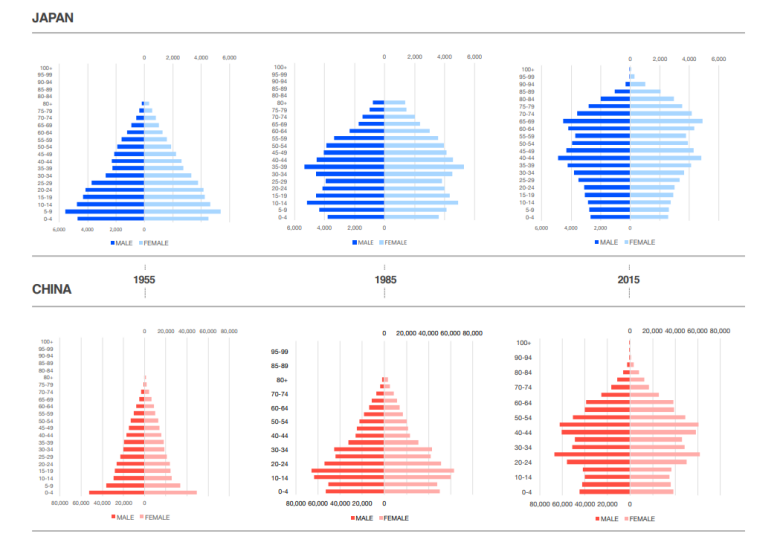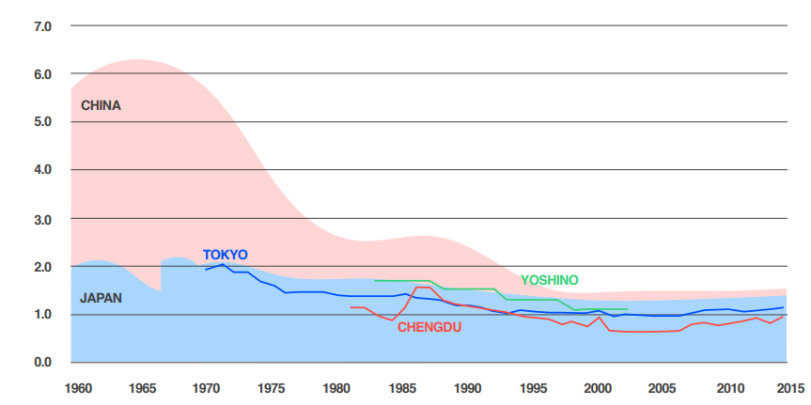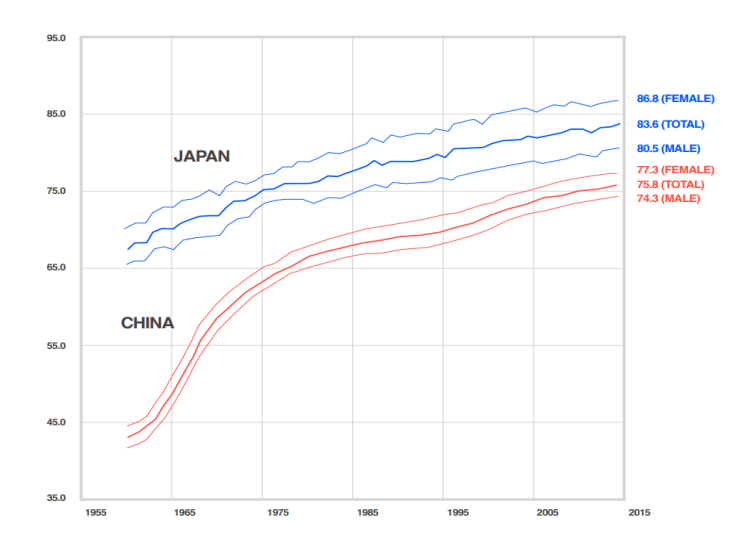APSS5202 Comparative Social Policy and Social Development
Term Paper Abstract
Name of student: Jiandong Peng
Paper Title: Comparative Study on Aging Population Between China and Japan
Background/Rationale
Most East Asian countries like China and Japan are facing the severe challenge in aging population. Demographic shifts, declining birth and fertility rate, and improved longevity are all factors leading to the decline of the overall population in East Asian countries. According to the UN statistics, there will be a decline in the population of an estimated 43 million in Japan by 2100 (Feldhoff, 2013). The emergence of the aging population problem can further lead to social transformation at the levels of individuals, families, communities, government, and society. In fact, each working adults and taxpayers have to support the cost of pensions, healthcare, and shifting needs in the urban infrastructure.
The major social challenges in China and Japan can be shown as follows:
Ø Improved longevity: people with pensions will be retired for longer. It exerts a significant influence on the social welfare system (Griffin, Hesketh & Loh, 2012).
Ø Low birth and fertility rate: The number of working adults in the workforce will keep shrinking. In other words, there will be less employed people to support retirees (Xue & Zhu, 2018).
Ø Depopulation in rural areas: Due to the rapid urbanization process in both China and Japan, the elderly citizens in rural areas will receive less and less support infrastructural support(Ogawa, 2001; Zou, Mishra & Luo, 2018). For instance, in rural areas, there are not assisted-living communities, daycare, health care, and memory care facilities.
Ø Changes in the Job Market: Immigrants have to be recruited to replenish the local job market due to aging population
Meanwhile, there are also many potential opportunities to meet the critical needs of senior citizens. Firstly, through designing public polices, allocating public resources, providing goods and services, the needs and demands of the elderly citizens can be effectively addressed. This report will explore the needs of Chinese and Japanese senior citizens. The result can be used to provide insights for policy-makers, governments, and private sectors to address their needs.
Secondly, through understanding the needs of Chinese and Japanese senior citizens, it is also possible to stimulate thinking on how aging may apply beyond China and Japan. The research results can also provide insights for policy-makers and business owners in other countries. According to Chen et al., (2019), the number of Chinese older than 65 will increase from 100 million in 2005 to 329 million in 2050. Therefore, the research result is sufficiently significant as the aging population in China along is much higher than many other countries in the world. Through conducting this research, China can lead the world in dealing with social challenges in regards to aging population.
The age pyramid as shown in figure shows the age distribution from 0 to 90 years old in China and Japan in 1950, 1985, and 2015 (METI Journal, 2015). It can be observed that people above 65 years old in both countries suddenly increase in 2015. The 65-69 age group in Japan is significantly large as compared with other demographic groups. It implies that the number of retirees keeps increasing. In other words, the working population is shrinking. Even though in China, the 65-69 age group seems to be smaller. But it is expected that China’s working force will keep shrinking in the next five years. In some sense, Japan has already suffered from the severe challenge of aging population. China will face the same problem sooner or later.

Source Credit: METI Journal, 2015
Fig 1: Age Pyramid of Japan and China in 1950, 1985, and 2015
The Fertility rate is an important indicator to indicate the average number of children that each woman delivers (Shrestha, 2000). The fertility rate is closely related to the demographic pattern of a country. High fertility rate means that the problem of aging population can be compensated by the increase in children and young people. Eventually, the working population will be large enough to support the social welfare and pension system. However, as shown in figure two, the fertility rate in China and Tokyo keeps decreasing. Both Japan and China have a fertility rate lower than 2.1.

Source Credit:METI Journal, 2015
Fig 2: Fertility Rate of China and Japan from 1960 to 2015
Besides, the longevity of Chinese and Japanese keeps increasing as shown in figure 3. Like the aforementioned, the higher longevity means that people will be retired for longer. It will exert a huge burden on the social welfare system (Wilding, 2008).

Source Credit:METI Journal, 2015
Fig 3: Life Expectancy in China and Japan from 1965 to 2015
Research objectives & Research Questions
Hence, the major objective is to explore the critical needs of Chinese and Japanese elderly citizens aged above 65 years old. Major problems with respect to the major challenges identified in the previous section will be analyzed and discussed through conducting a focused-group survey among research participants. Three questions have been designed to guide the direction of this study,
Ø What kind of challenges are senior citizens in rural and urban areas currently facing in Japan and China?
Ø How do high life expectancy and low fertility rate impact Japanese and Chinese society?
Ø What are major changes in Japan and China’s job market due to aging population.
Research design & Proposed methods
Comparative research methodology will be used in this research. Comparative research is commonly used in social science to make comparisons across different cultures or countries. Secondary analysis will be conducted in both countries with respect to aging population. In other words, secondary data will be cited from authoritative organizations to exhibit similarities and differences between two countries. It is important to use Japan to compare and contrast with China in this study. After identifying the major challenges, the researcher will propose recommendations to address these social problems. The research can provide insights for policy-makers, governments, and private sectors about how to address the needs of the elderly through implementing government policies, constructing health care and daycare facilities, or providing goods and services.
Reference
Chen, R., Xu, P., Song, P., Wang, M., & He, J. (2019). “China has faster pace than Japan in population aging in next 25 years”. Bioscience trends, 13(4): 287-291.
Feldhoff, T. (2013). “Shrinking communities in Japan: Community ownership of assets as a development potential for rural Japan?”. Urban Design International, 18(1): 99-109.
Griffin, B., Hesketh, B., & Loh, V. (2012). “The influence of subjective life expectancy on retirement transition and planning: a longitudinal study”. Journal of Vocational Behavior, 81(2): 129-137.
Glik, D. C., Parker, K., & Hategikamana, G. M. B. (2005). Integrating qualitative and quantitative survey techniques. International quarterly of community health education, 25(1), 115-133.
METI Journal.(2015).”Transformation - A Foundational Study on Aging In Japan and China.” Retrieved from: https://www.meti.go.jp/meti_lib/report/H28FY/000765.pdf
Ogawa, T. (2001). Social services for the elderly based on the new rurality: the Japanese experience. The Journal of Rural Health, 17(4): 374-377.
Shrestha, L. B. (2000). Population Aging In Developing Countries: The elderly populations of developing countries are now growing more rapidly than those in industrialized nations, thanks to health advances and declining fertility rates. Health affairs, 19(3), 204-212.
Wilding, P. (2008). “Is the East Asian Welfare Model still productive?”, Journal of Asian Public Policy, 1(1): 18-31.
Xue, T., & Zhu, T. (2018). Increment of ambient exposure to fine particles and the reduced human fertility rate in China, 2000–2010. Science of the total environment, 497-504.
Zou, B., Mishra, A. K., & Luo, B. (2018). Aging population, farm succession, and farmland usage: Evidence from rural China. Land Use Policy, 77, 437-445.